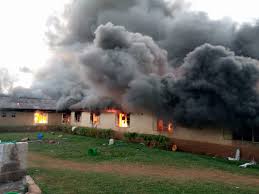
By Dr Christine Karanja-Chege, Dr Christine Wambugu and Dr Supa Tunje
Let us
start with a snapshot of a school dormitory in Kenya. Let us take a walk back
in time, way back to the four years we spent in a rural boarding school.
The thought
brings back memories of long dormitories with narrow double-decker beds
interspersed with small lockers atop which we precariously stacked our battered
suitcases and an assortment of other paraphernalia.
Fast
forward and make your way to any dormitory now, and if the sight of the long
room chock-full of triple-decker beds does not shock you, then the thought of
children, some younger than 10 years, sleeping on such contraptions might give
you a jolt.
Then let us
consider a day in the life of a young learner in boarding school.
The
learner’s day begins with a loud bell, rang sometimes as early as 4 am, jarring
them awake. A mad rush to the few available showers ensues, followed by the
scramble to get to class in time for the ‘morning prep’.
In a bid to
make sure schools maintain stellar performance records, rote learning is the
preferred method of instruction. Extra-curricular activities like sports,
music, drama and debate are sacrificed on the altar of academic excellence.
The long
day culminates with a ‘night prep’ that may end as late as 10 pm with learners
shuffling back to the dormitories for a few hours of much needed rest.
We have all at one time or another suffered the awful effects of sleep deprivation for a few days. This brings us to the question: “Why do we expect our children to function normally for months on end, and to grasp complex concepts with as little as 4 hours of sleep at night?”
The American
Academy of Sleep Medicine recommends that children aged 6–12 years should
regularly sleep for about 9–12 hours every 24 hours.
And that
adolescents (13- to 18-year-olds) should ideally get between 8–10 hours of
sleep every 24 hours for optimal growth and development. Sleep is essential for
learning, memory formation, emotional regulation, physical and mental
development.
On the
playground, even during rough-and-tumble play, skills such as teamwork,
negotiation and conflict resolution are fostered. Through music, art and drama,
the learners develop creativity and innovation, both of which are valuable
skills for adaptive learning. Children who lack these important attributes
later in life struggle to navigate the complexities of the workplace.
It does not
take a genius to decipher that a sleep deprived child bereft of any form of
relaxation, who has to contend with learning in such stressful conditions on a
daily basis, is a ticking time bomb waiting to explode.
We have in
recent years noted a growing phenomenon that occurs in boarding schools almost
every 3rd term during the season when national examinations take place.
Country-wide incidents of student unrest including arson, that culminate in destruction
of property have been seen to arise with alarming predictability, causing
significant disruption in learning, and – most tragically – serious injuries
and even loss of life.
The worst
case to date, of student-instigated arson, occurred in 2001 at Kyanguli Boys
Secondary School in Machakos. Two 16-year-old form 3 students, set ablaze a
dormitory that housed 100 boys, leading to 67 deaths. When questioned under
trial, they cited a number of reasons for this most heinous act, with hostility
between the school administration and the boys emerging as a key underlying
cause of discontent among the students.
Even as we
write this, the country has not yet recovered from mourning the deaths of 21
pupils that occurred on the night of 6th September 2024 at Hillside Endarasha
Academy, a mixed-boarding primary school in Nyeri County.
A fire,
thought to have been caused by an electrical fault, swept through a dormitory
housing 156 sleeping boys aged 9-14 years, razing it to the ground.
Eyewitnesses reported that the fire spread very quickly, and it was later
revealed that the long dormitory was partitioned into smaller sections with
highly combustible plywood.
Interventions
are required at two different levels here: in physical infrastructure upgrades,
and in addressing the psychological stressors which lead to students setting
fire to their own schools.
In terms of infrastructure, schools should consider embracing non-boarding schooling while the schools that already have boarding facilities need to build more dormitories to decongest the overcrowded existing ones.
We also
must do away with the unsafe triple-decker beds and provide the much safer
option of double-decker beds.
Dormitory
exits should be easily accessible by all occupants, free of obstructing
furniture and clearly marked.
Windows should be free of bars so that they can be opened with ease or even broken so as to serve as escape routes in case of a fire. Students need to have regular fire drills that demonstrate how to march to a designated assembly point once an alarm is sounded, avoiding the additional risk of serious injuries from a stampede.
Every dormitory must have a fire extinguisher, fire blanket as well as a sand bucket as these can be used to put out small fires. The fire alarm should be linked to an overhead water sprinkler system that should be triggered by any fire event.
Then there is the psychological dimension of the problem:
We must address the stressors that affect the mental status of our children such as sleep deprivation, lack of physical exercise, socio-economic changes among others.
These stressors, combined with the hormonal changes in a growing adolescent’s body may cause the learners to perceive the school authorities as hostile leading them to engage in thoughtless acts of destruction.
The Kenya Pediatric Association (KPA) has joined the rest of the nation in sounding the clarion call to action.
KPA is a professional organization of mainly pediatricians and other health professionals working with children and adolescents.












